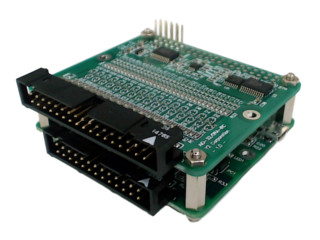USB-I2C変換ボード(DIO-8/4RE-UBC)を使用して、パソコンからアナログ値を測定する(Python)
python-ft4222がインストールされてない場合は、インストールします。
$ pip install ft4222
プログラムの作成
「test_aio320ra_ft4222.py」というファイル名で以下のファイルを保存します。
(または test_aio320ra_ft4222.py からダウンロードします)
import ft4222
import ft4222.I2CMaster
class PCA9554:
class Register:
InputPort = 0
OutputPort = 1
PolarityInversion = 2
Configuration = 3
def __init__(self, address, i2c):
self.address = address
self.i2c = i2c
def set_direction(self, value):
self.i2c.i2cMaster_Write(self.address, bytes([self.Register.Configuration , value]))
def write(self, value):
self.i2c.i2cMaster_Write(self.address, bytes([self.Register.OutputPort, value]))
class ADS1115:
class Register:
Conversion = 0
Config = 1
LoThresh = 2
HiThresh = 3
class SingleShotCoversion:
NoEffect = 0
Begin = 1
class Mux:
Ain0_Ain1 = 0
Ain0_Ain3 = 1
Ain1_Ain3 = 2
Ain2_Ain3 = 3
Ain0_Gnd = 4
Ain1_Gnd = 5
Ain2_Gnd = 6
Ain3_Gnd = 7
class PGA:
PGA_6_144V = 0
PGA_4_096V = 1
PGA_2_048V = 2
PGA_1_024V = 3
PGA_0_512V = 4
PGA_0_256V = 5
class Mode:
Continuous = 0
PowerDownSingleShot = 1
class DataRate:
DR_8SPS = 0
DR_16SPS = 1
DR_32SPS = 2
DR_64SPS = 3
DR_128SPS = 4 # Default
DR_250SPS = 5
DR_475SPS = 6
DR_860SPS = 7
class ComparatorQueue:
Disable = 0x03
def __init__(self, address, i2c):
self.address = address
self.i2c = i2c
def analog_read(self, mux, data_rate, pga):
self.i2c.i2cMaster_Write(self.address, bytes([self.Register.Config, self.SingleShotCoversion.Begin << 7 | mux << 4 | pga << 1 | self.Mode.PowerDownSingleShot, data_rate << 5 | self.ComparatorQueue.Disable]))
data = bytes([0])
while data[0] & 0x80 == 0:
data = self.i2c.i2cMaster_Read(self.address, 1)
self.i2c.i2cMaster_WriteEx(self.address, ft4222.I2CMaster.Flag.START, bytes([self.Register.Conversion]))
data = self.i2c.i2cMaster_ReadEx(self.address, ft4222.I2CMaster.Flag.REPEATED_START | ft4222.I2CMaster.Flag.STOP, 2)
word_data = data[0] * 0x100 + data[1]
if word_data >= 0x8000:
word_data -= 0x10000
return word_data
class AIO_32_0RA_IRC:
class PGA:
PGA_10_0352V = ADS1115.PGA.PGA_2_048V
PGA_5_0176V = ADS1115.PGA.PGA_1_024V
PGA_2_5088V = ADS1115.PGA.PGA_0_512V
PGA_1_2544V = ADS1115.PGA.PGA_0_256V
class DataRate:
DR_8SPS = ADS1115.DataRate.DR_8SPS
DR_16SPS = ADS1115.DataRate.DR_16SPS
DR_32SPS = ADS1115.DataRate.DR_32SPS
DR_64SPS = ADS1115.DataRate.DR_64SPS
DR_128SPS = ADS1115.DataRate.DR_128SPS
DR_250SPS = ADS1115.DataRate.DR_250SPS
DR_475SPS = ADS1115.DataRate.DR_475SPS
DR_860SPS = ADS1115.DataRate.DR_860SPS
multiplexerSettings = 0xff
def __init__(self, ads1115_address, pca9554_address, i2c):
self.ads1115 = ADS1115(ads1115_address, i2c)
self.multiplexer = PCA9554(pca9554_address, i2c)
self.multiplexerSettings = 0xff
self.multiplexer.write(self.multiplexerSettings)
self.multiplexer.set_direction(0)
def analog_read(self, channel, data_rate, pga):
if (channel < 16):
extMux = (self.multiplexerSettings & 0xf0) | channel
adcMux = ADS1115.Mux.Ain0_Gnd
elif (channel < 32):
extMux = (self.multiplexerSettings & 0x0f) | (channel & 0x0f) << 4
adcMux = ADS1115.Mux.Ain1_Gnd
elif (channel < 48):
extMux = (self.multiplexerSettings & 0xf0) | channel
adcMux = ADS1115.Mux.Ain0_Ain3
elif (channel < 64):
extMux = (self.multiplexerSettings & 0x0f) | (channel & 0x0f) << 4
adcMux = ADS1115.Mux.Ain1_Ain3
elif (channel < 256):
return 0
else:
extMux = channel & 0xff
adcMux = ADS1115.Mux.Ain0_Ain1
if (self.multiplexerSettings != extMux):
self.multiplexer.write(extMux)
self.multiplexerSettings = extMux
return self.ads1115.analog_read(adcMux, data_rate, pga)
def analog_read_volt(self, channel, data_rate = DataRate.DR_128SPS, pga = PGA.PGA_10_0352V):
if pga == self.PGA.PGA_1_2544V:
return float(0.256 * 49 / 10 / 32767 * self.analog_read(channel, data_rate, pga))
elif pga == self.PGA.PGA_2_5088V:
return float(0.512 * 49 / 10 / 32767 * self.analog_read(channel, data_rate, pga))
elif pga == self.PGA.PGA_5_0176V:
return float(1.024 * 49 / 10 / 32767 * self.analog_read(channel, data_rate, pga))
else:
return float(2.048 * 49 / 10 / 32767 * self.analog_read(channel, data_rate, pga))
dev = ft4222.openByDescription('FT4222')
dev.i2cMaster_Init(100)
aio = AIO_32_0RA_IRC(0x49, 0x3e, dev)
# アナログ入力値の読み出し(電圧値)(860SPS)
for channel in range(32):
print('CH{:d}: {:2.3f}V'.format(channel, aio.analog_read_volt(channel, aio.DataRate.DR_860SPS)))
動作確認
-
DIO-8/4RE-UBCのUSBケーブルを取り外します。
(電源の供給をオフする為) -
DIO-8/4RE-UBCとAIO-32/0RA-IRC をスタックして取り付けます。

-
DIO-8/4RE-UBCをパソコンとUSBケーブルで接続します。
電源が供給されますので、金属などの導電性のある物とボードが触れないように注意してください。
-
プログラムを実行します。
アナログ入力電圧が表示されます。
CH0: 5.205V CH1: 0.000V CH2: 0.000V ...
使用方法について
差動入力で使用する場合
analog_read_volt関数 または analog_read関数 で引数(channel)を以下の値にすることで、各差動入力チャネルの電圧を読み出すことが可能です。
channelの値 = 差動入力チャネル * 17 + 256
| channel | 差動入力チャネル | 接続先 |
|---|---|---|
| 256 | 差動入力チャネル0 | P1-1pinとP1-2pin |
| 273 | 差動入力チャネル1 | P1-3pinとP1-4pin |
| 290 | 差動入力チャネル2 | P1-5pinとP1-6pin |
| ・・・ |
必ず入力信号の基準電位(0V)を、AG(P1-33pin・P1-34pinどちらかのピン)に接続してください。